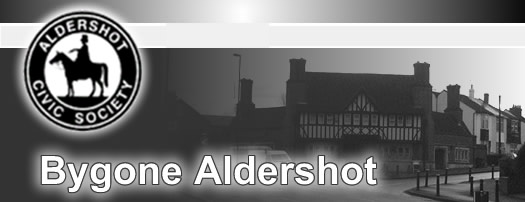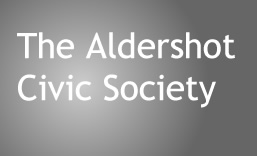Aldershot
From Kellys Directory of Hampshire 1898
Aldershot is a town and parish, with stations on the London & South Western and South Eastern railways and is one mile from the Basingstoke Canal 31/2 north by north east from Farnham, and 35 from London, Farnham union, and Farnham and Aldershot county court district, Odiham petty sessional division, Crondall Hundred, and in the rural deanery of Aldershot and archdeanery and diocese of Winchester. Prior to the establishment of a camp here in 1854 this was a mere village, but it has now grown into a considerable town, lying to the south of the barracks.
The town was made a Local Government District by the Act 20 & 21 Vict. c. 22 (1857), and was under the managment of a board of 15 members 12 chosen by the ratepayers and 3 by the Secretary of State for War, but under the provisions of the "Local Government Act, 1894" the town is now governed by an Urban District Council.
Both the town and camp are lighted with gas and supplied with water by the Aldershot Gas & Water Co. Limited. The supply of water is now of very good quality, and is obtained from the chalk about a mile distant from the town, by means of well boring, upwards of 240ft in depth there is areservoir with acapacity of 387,000 gallons, but the works are capable of supplying 1,000,000 gallons daily.
The parish church of St. Michael is an ancient edifice of brick in the Early English style and consists of chancel, nave of five bays, north aisle, south porch, and embattled western tower containing 3 bells: in the cahncel are tablets to the Tichborne family, once lords of the manor and owners of lands in this parish, and memorial windows placed in the chancel in 1886 to the late Capt. G. NEWCOMBE, in 1896 to the late vicar, and in 1897 to the late Major H. G. NEWCOMBE: the churchurch was restored and some stained windows erected during the period 1873-91 at a cost of £1600 and now affords 420 sittings. The register dates from the year 1571. The living is a vicarage, net yearly value £160, in the gift of the trustees of St. Cross Hospital, Winchester and held since 1893 by the Rev. John SEPPINGS GILL M. A. of Magdelen College, Oxford.
St. Augustines iron mission church in North Town was built in 1882 at a cost of £400.
Holy Trinity church in Victoria Road was erected during 1875-9 at a cost of £10000 for a district formed in 1878 in the new part of the town is a stucture of brick and stone facings in the Early English style from designs by Mr. STAPLEY architect of Farnham and consisting of chancel, nave with clerestory, aisles, north and west porches and vestry: the carved stone pulpit was presented by Mrs ANDERSON and the brass lectern by Mrs McDONALD; there are 900 sittings, 600 being free. The living is a vicarage, net yearly value £200, in the gift of trustees, and held since 1889 by the Rev. John de VERD LEIGH M.A. Corpus Christi college Cambridge.
Holy Trinty iron misssion church is in Queens Road.
The Catholic chapel of St. Joseph, is in Queens road, is an iron building with 400 sittings.
The Wesleyan chapel and Soldiers Home in Grosvenor road erected in 1874 at a cost of about £15000 affords 12 sittings, about one half being free: the home is maintained by voluntary subscriptions and is open free to all soldiers.
The English Presbyterian church in Victoria road, was erected in 1863 at a cost of £5000 and has 700 sittings.
The Primitive Methodist chapel in Victoria rd was erected at a cost of £6500 and will seat 550 persons; there is also a small Primitive Methodist chapel in the Ash Road erected at acost of £1100 and seating about 200.
The Baptist chapel in Uper Elms road, Carget was erected on a site given by Mr. W. ALDDEN at a cost of £1000 and will seat 400. The Particular Chapel in Victoria Road has about 200 sittings. The cemetery in Redan Hill, was formed in 1860, at a cosy of £1700, and enlarged in 1894, at a cost of £1050: there are now 13 acres of ground, with two chapels, one for the Church of England and one for the Nonconformists: it is under the control of a burial board of 9 members.
The Lock Hospital in the Farnham Road, is now managed by a committee composed of 6 guardians of the Farnham Union and 6 of the Harlet Wintney Board; the unions contribute respectivel two-thirds and one third of the balance required from the poor's rate. The Aldershot Cottage Hospital, in Church Lane was opened on August 13th 1897, and has 10 beds for patients.
The county Polisce Station is in the High Street. In the town are three brickworks.
The Theatre Royal, in Gordon Road built in 1891 will hold about 1500 persons; lessee and manager, Mr. Clarence SOUNES.
Races are held here in the spring on a course in Long Valley adjoining Ewshot, and also at the North Camp.
The Ecclesiastical Commissioners are lords of the manor of Crondall. The principal landowners are the Crown, Mrs NEWCOMBE, Messr. TRIMMER, SIMMONDS, RUSSELL, CHRISTMAS, BRAKE, STEVENS, Miss KENNEDY, and Mrs, STOVOLD. In 1841 the parish contained about 2700 acres of lheath and common land, 731 acres of arable land, 19 acres of hop land 530 acres of meadow and pasture land, 130 acres of woodland and 20 acres of building sites and gardens. The area is 4148 acres chiefly common and heath and 30 of water; rateable value £112,401; the population in 1891 was 25, 595, including 12,954 military in the south camp; the poulation of St. Michael ecclesiastical parish in 1891 was 16,950 and of the Holy Trinity ecclesiastical parish was 8,645. Parish Clerk, William FLUDDER, Rose Cott. Church Lane.
<< back
|
|
|


